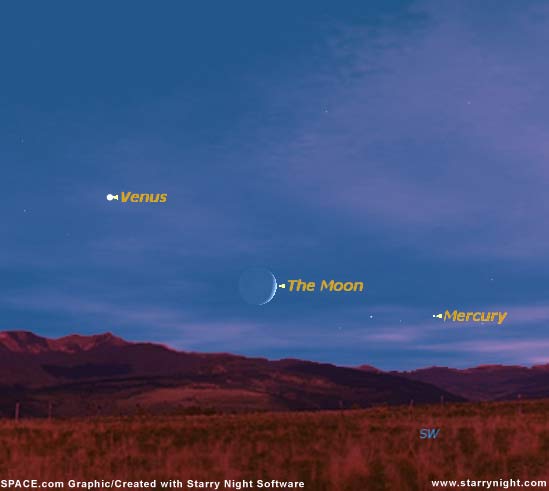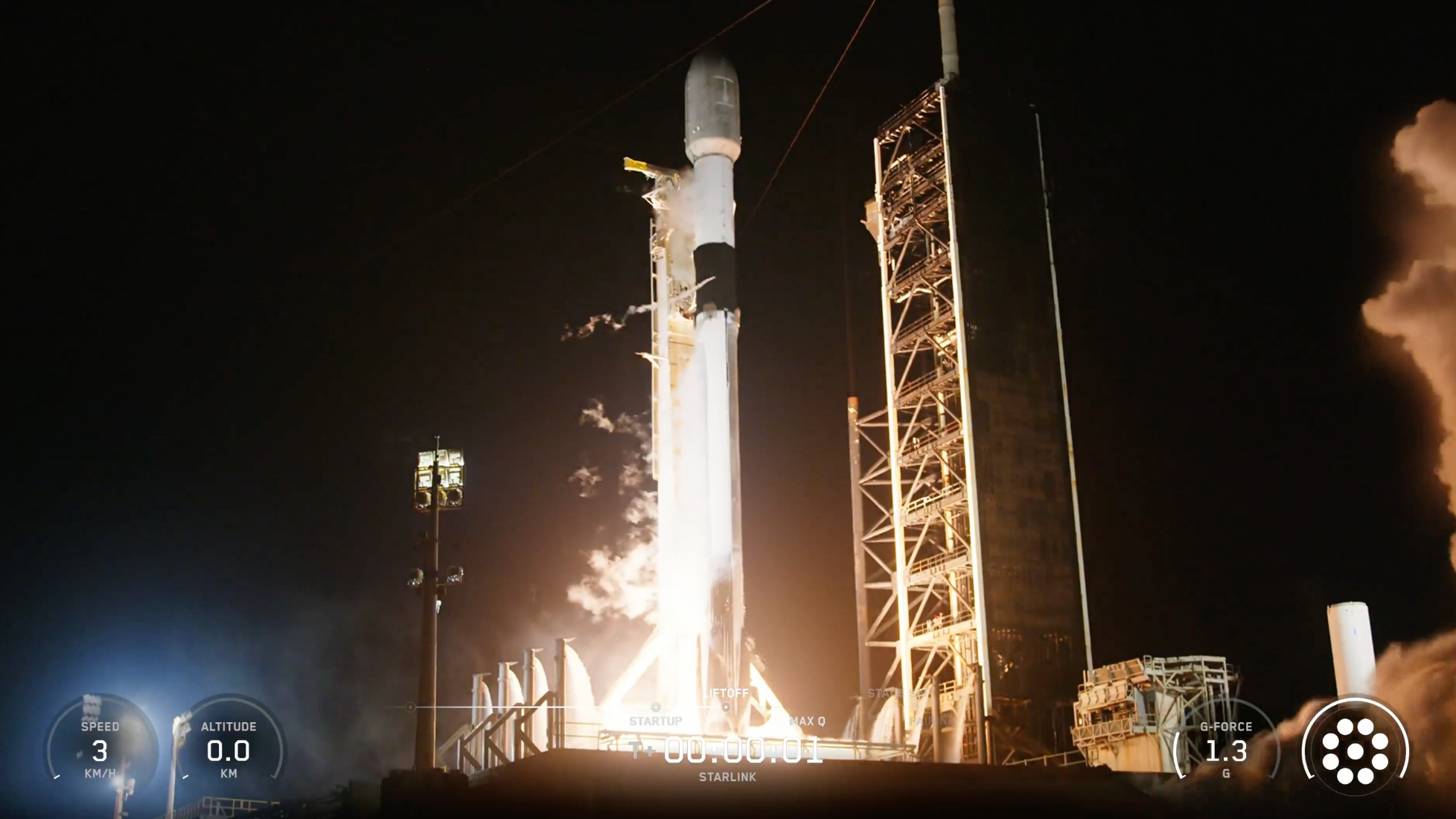Explore Venus Tonight

The planet getting the most attention in our evening sky lately is Mars. It passed closest to the Earth Oct. 29 at just more than 43 million miles. Blazing like a dazzling topaz beacon at magnitude -2.3, Mars has become the night's premier celestial attraction.
And yet, it still shines with less than one-sixth the intensity of the brightest planet in the sky: Venus.
Indeed, Venus is the first planet you'll spot as darkness falls. You can even see it before sunset if you know just where to look in the southwest sky. It is gaining altitude in the twilight, boldly showing itself off after six months of hiding behind any inconvenient obstructions near the southwestern horizon.
Venus is brightening too, since it is speeding toward Earth as it catches up to us in its faster orbit around the Sun.
Traveling in phases
As Venus travels around the Sun inside the Earth's orbit, it alternates regularly from evening to morning sky and back, spending about 9½ months as an "evening star" and about the same length of time as a "morning star."
Some ancient astronomers actually thought they were seeing two different celestial bodies. They named the morning star after Phosphorus, the harbinger of light, and the evening star for Hesperus, the son of Atlas. It was the Greek philosopher and mathematician Pythagoras who first realized that Phosphorus and Hesperus were one and the same object.
Breaking space news, the latest updates on rocket launches, skywatching events and more!
To the ancients, such behavior was puzzling and was not really understood until the time of Galileo.
After moving to Pisa in the autumn of 1610, he started observing Venus through his crude telescope. One evening he noticed that a small slice seemed to be missing from Venus' disk. After several more months, Venus appeared in the shape of a crescent - in other words, it seemed to display the same phases as the Moon.
This was a major discovery, which ultimately helped to deliver a deathblow to the long-held concept of an Earth-centered universe.
Venus wanders only a limited distance east or west of the Sun, since, like Mercury, it is an "inferior" planet (orbiting the Sun more closely than Earth does). Watching its movement is akin to watching an auto race from the grandstand: all the action takes place in front of you and it's necessary to turn only a limited amount either way to see it at all. In contrast, for "superior" planets (those located in orbits beyond the Earth from the Sun), viewers on Earth are like the pit crews inside the racetrack who must turn in all directions to follow the cars.
When Venus is on the opposite side of the Sun from us, it appears full (or nearly so) and rather small because it is far from us. But because Venus' moves with a greater velocity around the Sun than Earth, it gradually gets closer and looms progressively larger in apparent size; the angle of sunlight striking it as seen from our Earthly vantage point also appears to change as well.
Ultimately, as Venus prepares to pass between the Earth and the Sun it appears as a thinning crescent. And since at this point in its orbit it is nearly six times closer to us compared to when it was on the opposite side of the Sun, it appears much larger to us as well.
Venus: Now through January
How Venus' appearance will change during the coming weeks:
2005 November 3 - Greatest Eastern Elongation: Venus passed that point in the sky where it attained its greatest angular distance (47º) from the Sun and sets about 2½-hours after sundown. In our solar system geometry, Venus now makes a right angle with both the Sun and Earth. In terms of apparent size, Venus now appears more than twice as large as it was at the end of July. In a small telescope Venus is now a dazzling silvery-white "half-moon." In the nights that follow it gradually becomes a fat crescent while growing ever larger as it swings around in its orbit closer to Earth.
2005 November 5 -- Venus and the crescent Moon will make for an eye-catching sight in the west-southwest sky right after sunset. Venus will shine above and to the right of the slender sliver of the Moon. You should also be able to see the full globe of the Moon, its darkened portion glowing with a bluish-gray hue interposed between the sunlit crescent and not much darker sky. This vision is sometimes called "the old moon in the young moon's arms." Leonardo da Vinci (1452-1519) was the first to recognize it as earthshine. That dim bluish-gray light is light from the Earth reflected back to the Moon. The Earth's light of course is reflected sunlight, so earthshine is really sunlight which is reflected off Earth to the Moon and reflected back to Earth. Another, similar pairing-off between the Moon and Venus will take place on the evening of December 4.
2005 December 9 -- Greatest Brilliancy: Venus is now truly dazzling, shining at magnitude -4.5 and setting nearly three hours after the Sun. It is so bright now that it can be seen easily with the naked eye in a deep blue, haze-free afternoon sky. It continues to approach the Earth while appearing to curve back in toward the Sun in our sky. In a telescope it is now a big, beautiful crescent that grows larger and thinner with each passing night. The crescent can be glimpsed even in steadily held binoculars. Venus now stands 37 million miles from the Earth, nearer than even the recent close approach of Mars in late October. Its disk appears 25 percent illuminated and it now appears about 35 percent larger in size than it did just one month ago.
2005 December 24 - Disk 12 percent illuminated: The crescent of Venus continues to narrow, but because it also continues to approach our Earth, it appears to greatly lengthen as well. It's now 29 million miles away, but it's also in a rapid plunge down the sky toward the Sun; it's now setting just over two hours after sunset. Compare the appearance of its two cusps. Can you make out the crescent's "cusp extensions" - threadlike wisps of light extending beyond the crescent's points?
2005 December 31 - Disk just 6 percent illuminated: It is now critical to try and locate Venus as early as possible when it is still high in the sky in a steady atmosphere. Well before sunset is best. At sunset as seen from midnorthern latitudes, Venus stands about 15º above the southwest horizon and sets about 100 minutes later. Now less than 27 million miles from the Earth, Venus is becoming more and more aligned between us and the Sun and as such is turning more and more of its dark side toward us. A week from now, it will be all but gone from the evening sky.
2006 January 13 - Inferior Conjunction. Venus will finally transition from an evening to morning star and will appear to pass between the Earth and the Sun on this day. By the morning of January 19 Venus is emerging as a new morning "star" rising in the east-southeast at mid-dawn. It can be found about 6º above the horizon a half-hour before sunrise. A line from the star Deneb, in Cygnus through the star Altair, in Aquila points right at it. After another week you should see it easily from anywhere with an open east-southeastern view 45 minutes to an hour before sunrise.
Basic Sky Guides
- Full Moon Fever
- Astrophotography 101
- Sky Calendar & Moon Phases
- 10 Steps to Rewarding Stargazing
- Understanding the Ecliptic and the Zodiac
- False Dawn: All about the Zodiacal Light
- Reading Weather in the Sun, Moon and Stars
- How and Why the Night Sky Changes with the Seasons
- Night Sky Main Page: More Skywatching News & Features


Joe Rao serves as an instructor and guest lecturer at New York's Hayden Planetarium. He writes about astronomy for The New York Times and other publications, and he is also an on-camera meteorologist for News 12 Westchester, New York.
| DEFINITIONS |
1 AU, or astronomical unit, is the distance from the Sun to Earth, or about 93 million miles. Magnitude is the standard by which astronomers measure the apparent brightness of objects that appear in the sky. The lower the number, the brighter the object. The brightest stars in the sky are categorized as zero or first magnitude. Negative magnitudes are reserved for the most brilliant objects: the brightest star is Sirius (-1.4); the full Moon is -12.7; the Sun is -26.7. The faintest stars visible under dark skies are around +6. Degrees measure apparent sizes of objects or distances in the sky, as seen from our vantage point. The Moon is one-half degree in width. The width of your fist held at arm's length is about 10 degrees. The distance from the horizon to the overhead point (called the zenith) is equal to 90 degrees. Declination is the angular distance measured in degrees, of a celestial body north or south of the celestial equator. If, for an example, a certain star is said to have a declination of +20 degrees, it is located 20 degrees north of the celestial equator. Declination is to a celestial globe as latitude is to a terrestrial globe. Arc seconds are sometimes used to define the measurement of a sky object's angular diameter. One degree is equal to 60 arc minutes. One arc minute is equal to 60 arc seconds. The Moon appears (on average), one half-degree across, or 30 arc minutes, or 1800 arc seconds. If the disk of Mars is 20 arc seconds across, we can also say that it is 1/90 the apparent width of the Moon (since 1800 divided by 20 equals 90). |

Joe Rao is Space.com's skywatching columnist, as well as a veteran meteorologist and eclipse chaser who also serves as an instructor and guest lecturer at New York's Hayden Planetarium. He writes about astronomy for Natural History magazine, Sky & Telescope and other publications. Joe is an 8-time Emmy-nominated meteorologist who served the Putnam Valley region of New York for over 21 years. You can find him on Twitter and YouTube tracking lunar and solar eclipses, meteor showers and more. To find out Joe's latest project, visit him on Twitter.
